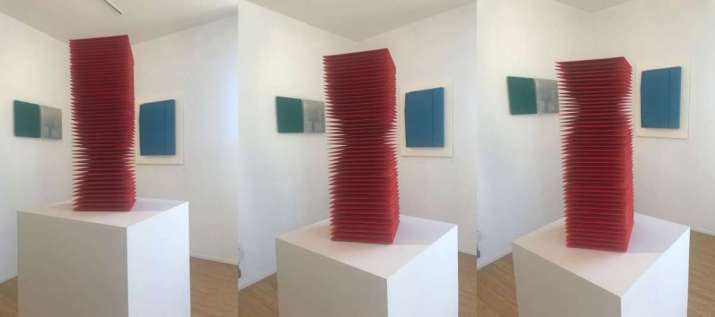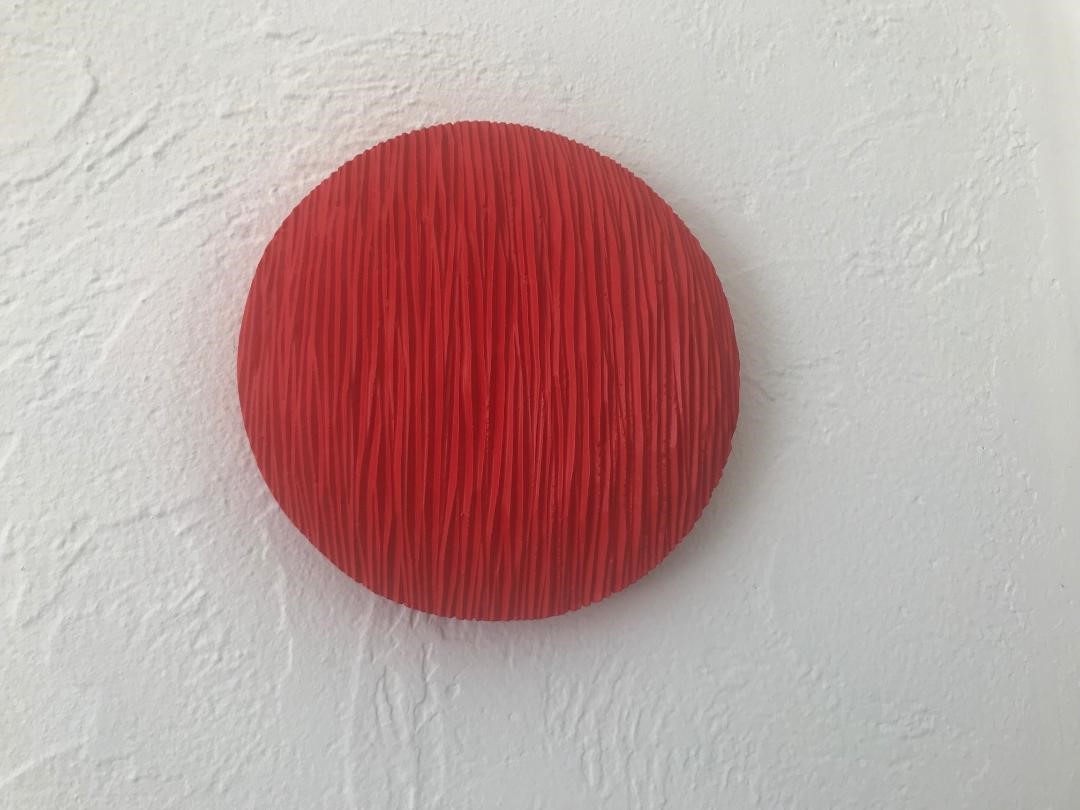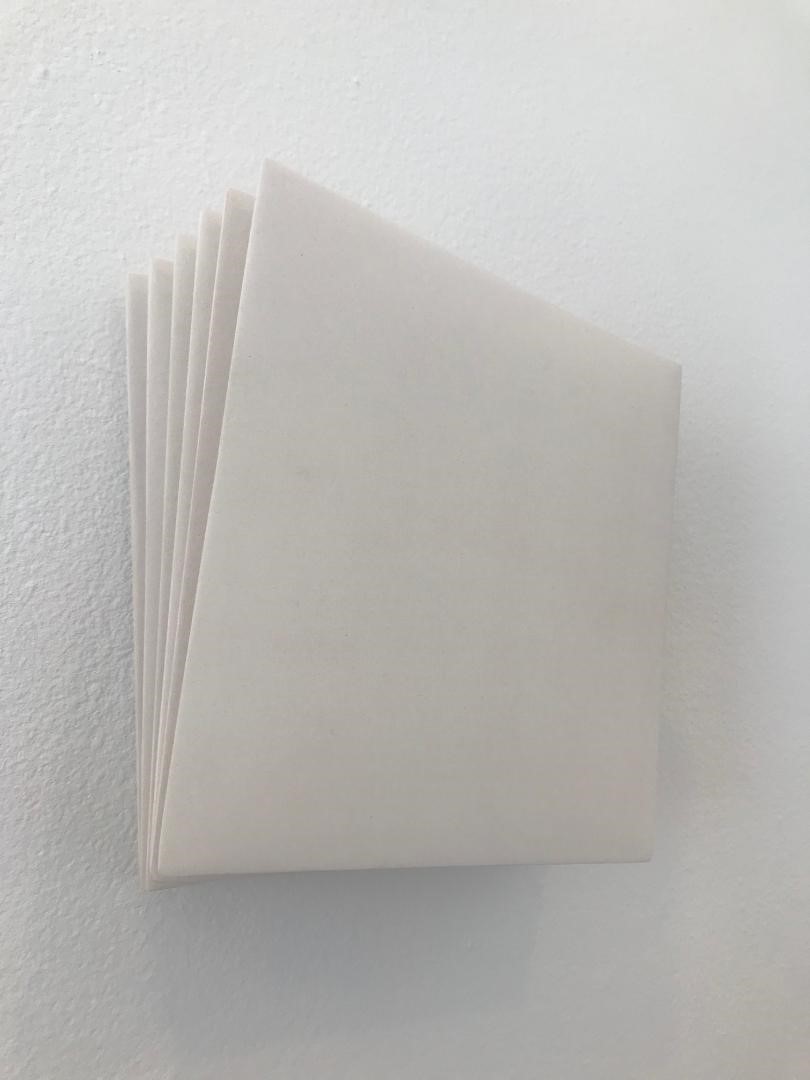FEATURES|COLUMNS|Buddhist Art
Challenging Reality: The Painted Sculptures of Masayuki Tsubota
 Three views of untitled work (The Layer of Self series) by Masayuki Tsubota, 2019. Gesso, pigments, and acrylic on basswood, 58.5 x 23 x 20.5 centimeters. Image courtesy of the artist and MOË Gallery. Photo by the author
Three views of untitled work (The Layer of Self series) by Masayuki Tsubota, 2019. Gesso, pigments, and acrylic on basswood, 58.5 x 23 x 20.5 centimeters. Image courtesy of the artist and MOË Gallery. Photo by the authorSomething very peculiar happens when you approach the multi-tiered wooden sculptures of Japanese artist Masayuki Tsubota. His carved and painted vertical towers appear to change form. The towers are masterfully built up of subtly convex square layers carved from basswood and painted in bold acrylic hues so that their forms are “flexible.” As the viewer moves around the gallery space, the central core of the tower appears to taper and swell depending on the viewer’s position, creating a sort of visual vibration. I recently encountered one such work, a red tower made up of carved wooden squares, at MOË Gallery in Los Angeles (on view until 17 July) while Tsubota was still in Los Angeles. As I walked back and forth and around the piece remarking aloud at its variable form, the artist laughed and nodded, clearly pleased that it was having the desired effect of making me question my sense of reality.

Untitled (The Wall of Self series) by Masayuki Tsubota, 2016.
Gesso, pigments, and acrylic on basswood, 20 x 4.5 centimeters.
Image courtesy of the artist and MOË Gallery. Photo by the author
Masayuki Tsubota was born in Osaka in 1976, graduating from Osaka University with a master’s degree in arts in 2004. Since then, he has worked primarily in carved and painted wood. Over the last 15 years, he has become renowned for his simple, elegant sculptural forms that combine a refined sense of modernism with the warmth of handcrafted work. The surfaces of many of his pieces are textured with chisel marks and coated with vibrant traditional Japanese mineral pigments in a poetic union of sculptural technique and painting material. In some works, he partners these textured pieces with works that are coated in gold, silver, and tin leaf, creating a rich harmony of contrasts that can be evocative of gentle land and seascapes. Working in a range of sizes, Tsubota features his work in regular gallery shows in Japan, Korea, and Taiwan, and has been commissioned to create works for installations in more than 80 public spaces, including the Intercontinental Hotel in Osaka, Tokyo Gardens Terrace Kioi in Tokyo, and Nanggang Station in Taipei.

Untitled (The Wall of Self series) by Masayuki Tsubota, 2017.
Gesso, powdered mineral pigments, glue on basswood, and tin foil, 30 x 50 x 5 centimeters.
Image courtesy of the artist and MOË Gallery
Tsubota is quick to acknowledge that there is a deep spiritual quality to his work. Tsubota considers each of his carvings to be a life work–a “diary in human life of the modern day.” As such, he chooses not to give the works titles, explaining, “I wish for them to be seen as pure art that is autonomous as a single work without being subordinate to the environment or words.” Instead, he groups the works into three categories: The Layer of Self, The Wall of Self, and The Center of Self. As I gazed at the painted sculptures on the walls or standing on pedestals, I could not help but contemplate the nature of the self, how it is perceived, and the many ways it can be challenged and transformed.
Although it is not apparent in the highly contemporary style of his work, Tsubota is influenced by the woodcarvings of Japan’s most renowned Buddhist sculptors, or busshi, from the Kamakura period (1185–1333). Growing up in the Kansai region, he was acutely aware of the work of the Kei school of sculptors, who carved many of Japan’s most treasured wooden Buddhist images in the temples of Nara and Kyoto and, in the later Kamakura, near modern Tokyo. According to the MOË Gallery’s director Ryo Araki, “Just as the sculptor Unkei [c.1150–1223] created shapes that could only be born at that time, such as the expression of aesthetics and philosophical views of nature, Tsubota’s work is born from the philosophy and aesthetics of the modern time.”

Untitled (The Layer of Self series) by Masayuki Tsubota, 2019.
Gesso, pigments, and acrylic on basswood, 58.5 x 23 x 20.5 centimeters.
Image courtesy of the artist and MOË Gallery
Tsubota also draws a connection between his work and elements of Buddhist architecture, particularly the pagodas that are important elements of Japan’s oldest temple complexes. Originally evolved from the Indian stupa—burial mounds housing the relics of great teachers or rulers—the East Asian pagoda is typically a wooden structure with multiple tiers, typically five or seven in Japan. Because pagodas also house sacred relics, Buddhist practitioners have traditionally circumambulated these structures in a type of walking meditation. Similarly, Tsubota’s layered towers, with their odd numbers of storeys, invite the viewer to walk around them in an almost spiritual exploration of structure, form, and reality.

Untitled (The Layer of Self series) by Masayuki Tsubota, 2019.
Gesso on basswood, 23.5 x 23 x 8 centimeters.
Image courtesy of the artist and MOË Gallery
Gazing at another of Tsubota’s sculptures, formed of layers of white wood, I again found myself questioning the reality of what I was looking at. The squares of wood, painted to look like sheets of paper, tilted toward me as if peeling away from the white gallery wall. The piece appears at once strong and secure, yet fragile and unstable as it leans out toward the viewer. I could not help but begin to examine the concept of strength and stability in the artwork and in human existence. Tsubota’s exploration of human life in a daily diary of carved and painted wood gives us plenty to contemplate as we look outward to the art, but even more as we look inward to our selves.
Related features from Buddhistdoor Global
The Buddhist Roots of Japanese Flower Arrangement
Alternate Realities in the Paintings of Wakana Kimura
Contemplating the Kalpa in the Art of Hirokazu Kosaka
From Manga to Monks, Anime to Arhats: Recent Buddhist Themes in the Art of Takashi Murakami
Protected on All Four Sides: The Propagation of Guardian King Iconography














